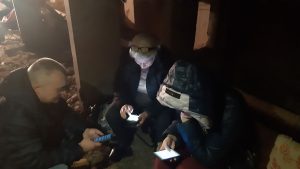Displacement in Ukraine – the numbers
Almost 5.1 million people are now estimated to be displaced across Ukraine, according to a new report from the UN’s migration agency IOM.
About 4.76 million people have returned home from displacement, of which 1.1 million have returned from abroad, the report says.
The number of returnees has steadily increased since the start of the full-scale war in February 2022. But now eighty per cent of the displaced population have cited financial assistance as a key need.
“With so many people displaced for a year or more, savings have been depleted and vulnerabilities compounded, undermining the resilience of war-affected Ukrainians.” said IOM spokeswoman Anh Nguyen, in a media statement.
“Nationwide, less than half of those displaced are currently employed. Financial distress influences the decisions that displaced households make about their futures – whether to relocate, return or integrate.” Mr Nguyen said.
The IOM report says the longer displacement lasts, the more vulnerable people become and without adequate finances, they have little-or-no agency over the period of displacement.
“Lack of employment opportunities in a displacement location, for example, means that a displaced family is less likely to integrate into that community.” the report said.
“Failure to integrate could contribute to increased reliance on negative coping mechanisms or lead to pre-mature returns before it is safe to do so.”
Alarmingly, 65 per cent of internally displaced people live in households with a monthly income level per household member equal to or less than $US125, an amount deemed a subsistence minimum.
The report also cites evidence of growing inter-group tension in communities across Ukraine, which is related to different levels of eligibility for social and humanitarian assistance.
“Around a quarter of the internally displaced population reported that they were considering leaving their current location, and 3.3 million people intend to eventually return,” the IOM report said.
“The primary reason being the desire to resume a normal life or missing home and other sentimental reasons (64 per cent), followed by the intention to reunite with their family (25 per cent), owning a property in the place of origin (22 per cent), economic reasons such as the possibility of earning an income (21 per cent) and low perception of security in the current location (3 per cent).”
Nearly half of the people surveyed had returned from another region within Ukraine, with a further third returning from displacement within their own home region, most notably Chernihiv, Mykolaiv and Kharkiv regions.
The top three regions where people are returning to are Kyiv City, Kyiv and Kharkiv regions, while the areas they are returning from include Kyiv City, Lviv and Vinnytsia region.
Of the 1.1 million who reported returning from another country, most returned from Poland (39 per cent), followed by Germany (9 per cent), Italy (7 per cent), Czechia (6 per cent) and Bulgaria (5 per cent), the report said.
Fifty per cent of all the people who remain internally displaced are concentrated in just five regions: Kharkiv, Dnipropetrovsk, Kyiv and Odesa as well as Kyiv City. These regions have remained the top five hosting locations since January 2023.
“More than a quarter of displaced persons have stayed within their home region or even district when possible, hoping to return once safe enough to do so or without means to travel further. The majority of displaced people originated from eastern Ukraine,” the report said.
The report was based on data gathered by IOM at the end of May 2023 in a bid to understand more about displacement, mobility flows, intentions, and conditions of life and as a way of informing targeted assistance to the war-affected populations.
A survey has found that 44 per cent of the over 1 million Ukrainian refugees who came to Germany to escape the war hope to stay in the country.
The survey indicated that the number of Ukrainian refugees who would like to stay in Germany has increased by 5 per cent and currently it makes 42, compared to 39 per cent as of the end of summer 2022.
Meanwhile, 18 per cent of those surveyed have found a job, which is only 1 per cent higher compared to the summer of 2022. This was facilitated by the fact that three-quarters of refugees had attended or completed German language courses.
According to the survey, women with children face greater challenges in finding work. Half of the Ukrainian women who came to Germany as refugees after Russia’s full-scale invasion of their home country in February 2022 have at least one child.
Only 3 per cent of women with minor children are currently employed, mainly because most do not have a partner in Germany, while 23 per cent of men with little children are employed since they usually have a partner.
The survey was jointly carried out by the German Institute for Economic Research, the Institute for Employment Research (IAB), the German Ministry for Migration and Refugees, and the Federal Institute for Demographic Research.












